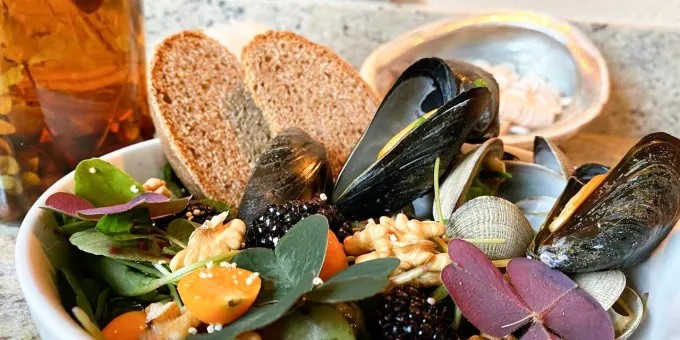Phoebe Hearst would have loved Cafe Ohlone, the 40-seat, reservations-only restaurant in Berkeley, located on the Bancroft Street side of the Museum of Anthropology that bears Hearst’s name. While it’s impossible to say if Hearst would have preferred the tan oak acorn bisque or the venison and mushroom stew, which features hand-gathered chanterelle, oyster, and morel mushrooms, it is definitely true that Hearst was a friend of the Ohlone. Indeed, she was their neighbor.
“She is still referred to by the elders as Auntie Phoebe,” Cafe Ohlone cofounder Vincent Medina says. “Hearst lived in a mansion immediately across a creek from the Alisal Rancheria, where our family lived until the 1920s. She employed Ohlone girls and young women, providing some economic safety at a time of extreme hardship for our people. There are stories,” he adds, “about how, after they were done working, she would ask them to stand on the roofs of their casitas and wave once they got home, to make sure they had all gotten across the creek safely. She cared for the families.”
As a friend of these families, Hearst (1842–1919) would have probably been less enamored with the actions of her namesake institution, which like the rest of the University of California, Berkeley, sits on Ohlone land that was stolen from the tribe. As it turned out, this was not even the worst of the many indignities to befall the Ohlone. “The university erroneously declared our people extinct in 1925,” Medina says, “which led to the loss of our family’s federal recognition, something that our great-grandparents actually lived through.”
In addition to collecting woven baskets and other cultural objects produced by Indigenous artisans throughout California, the university’s anthropologists also collected countless human remains. “They removed thousands of our ancestors from our cemeteries,” Medina says. Today, their bones are still secreted away at the Hearst Museum. As of spring 2023, the museum is closed until the repatriation of those remains is resolved.
Given this fraught history, dining at Cafe Ohlone, where the prix fixe menu can run in excess of $100 per person, is obviously about more than just grabbing a quick bite. In fact, one of the central missions of Cafe Ohlone is to be, as Medina puts it, “a constant reminder that the Ohlone people are here, that our culture is alive, that we’ve never left our home, and that we’ll be here tomorrow. Before every meal, we share the context of why we’re doing this work with our guests, speaking honestly about our history, from the times before colonization to where we are today. When people know those things, we believe they can’t unknow those things.”
Food, of course, is a tried-and-true way to experience a culture. In the case of Ohlone cuisine, though, the challenge is not just to learn how to savor new flavors but also to expunge from one’s mind the preconceptions one might have about Native American cooking.
“Oftentimes when I was a child,” Medina recalls, “I’d pick up a book on California Indians, and everything was described so disrespectfully. Acorn soup would be referred to as ‘acorn gruel.’ But preparing acorns is a long process—it takes about six months from beginning to end to make acorn soup, and even longer to make acorn bread. It involves gathering the acorns, curing them, preparing the flour, leaching out the tannic acid, cooking the acorn into the soup, and then cooking it down further. During the salmon run that traditionally went through San Francisco Bay, salmon that had been caught and smoked would be dipped into that acorn soup; the oils of the salmon would blend so nicely with the sweetness of the prepared acorn. Our food is extremely elegant and sophisticated,” Medina says.
As an outdoor restaurant, Cafe Ohlone is shaded by valley oaks, sycamores, and a built ramada. “The space itself represents living culture,” Medina says. “There’s an abalone curtain that you walk through and a shellmound in the back that’s full of plant life. And we always keep a table open for our elders and families in case any members want to come in and have a meal with us. Our elders are seated at the head of the table, and you see how represented they feel.”
You can be a part of this family, too, and while your experience at Cafe Ohlone may last only a few hours, what you learn about the Ohlone will stay with you for the rest of your life.
The lessons are more hopeful than you might think, all things considered. “Colonization caused a lot of sadness, no question about that,” Medina says, “but for too many thousands of years to count, our people lived good, happy, meaningful, sophisticated, and rich lives.” In the end, Medina says, the story of “how people transcended the hardships of colonization and kept the culture alive, even though a lot of unfair things happened, shows the love that our people have always had for our culture, the land, and family. Look at us through that lens—the lens of triumph, victory, persistence, strength, and power. Those are traits we want people to associate us with.”
